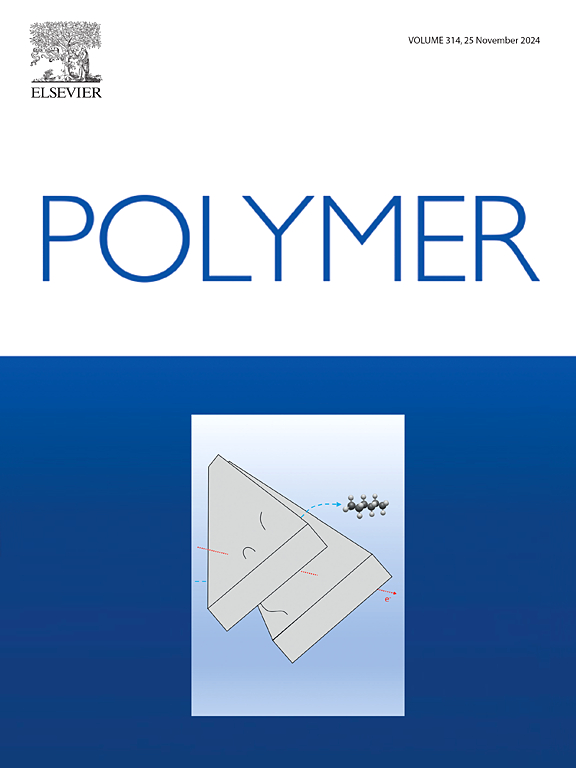Ternary copolymer strategy enables solubility-mediated aggregation control for high-performance ternary all-polymer solar cells
IF 4.1
2区 化学
Q2 POLYMER SCIENCE
引用次数: 0
Abstract
The ternary strategy has emerged as a pivotal approach for achieving high-performance organic solar cells (OSCs). Herein, we introduce a structurally compatible ternary polymer donor, PMz-5, into the PBQx-TF:PY-IT binary system to mitigate excessive aggregation of PBQx-TF. PMz-5 exhibit excellent miscibility with PBQx-TF in ternary films due to their similar building blocks. Systematic investigations reveal that PMz-5 forms an alloy-like structure with PBQx-TF, inducing a monotonic increase in open-circuit voltage (VOC) in ternary devices. This synergistic interaction not only boosts addition charge transfer from PBQx-TF to PMz-5 through forming favorable energy level alignment but also suppresses the charge recombination by regulating the crystallite coherence length and phase-separation domain size in the photoactive layer. Consequently, the optimized ternary blend film exhibits refined morphology and enhanced charge dynamics, achieving a champion PCE of 17.15 % with a short-circuit current density (JSC) to 24.33 mA cm−2, a VOC of 0.952 V, and a fill factor (FF) of 74.03 %. This work demonstrates that third component engineering with judiciously designed ternary polymers can simultaneously address morphological and electronic challenges in all-polymer solar cells (APSCs), offering a generalized framework for advancing multi-component OSCs through molecularly tailored strategy.


三元共聚物策略实现了高性能三元全聚合物太阳能电池溶解度介导的聚集控制
三元策略已成为实现高性能有机太阳能电池(OSCs)的关键方法。在此,我们将结构相容的三元聚合物给体PMz-5引入到PBQx-TF:PY-IT二元体系中,以减轻PBQx-TF的过度聚集。PMz-5与PBQx-TF在三元薄膜中表现出优异的混相性,这是由于它们具有相似的构建块。系统研究表明,PMz-5与PBQx-TF形成合金状结构,导致三元器件开路电压(VOC)单调升高。这种协同作用不仅通过形成有利的能级排列促进附加电荷从PBQx-TF向PMz-5的转移,而且通过调节光活性层中晶体相干长度和相分离畴大小抑制电荷复合。结果表明,优化后的三元共混膜形貌精细,电荷动力学增强,PCE为17.15%,短路电流密度(JSC)为24.33 mA cm-2, VOC为0.952 V,填充系数(FF)为74.03%。这项工作表明,采用合理设计的三元聚合物的第三组分工程可以同时解决全聚合物太阳能电池(APSCs)的形态和电子挑战,为通过分子定制策略推进多组分太阳能电池提供了一个通用框架。
本文章由计算机程序翻译,如有差异,请以英文原文为准。
求助全文
约1分钟内获得全文
求助全文
来源期刊

Polymer
化学-高分子科学
CiteScore
7.90
自引率
8.70%
发文量
959
审稿时长
32 days
期刊介绍:
Polymer is an interdisciplinary journal dedicated to publishing innovative and significant advances in Polymer Physics, Chemistry and Technology. We welcome submissions on polymer hybrids, nanocomposites, characterisation and self-assembly. Polymer also publishes work on the technological application of polymers in energy and optoelectronics.
The main scope is covered but not limited to the following core areas:
Polymer Materials
Nanocomposites and hybrid nanomaterials
Polymer blends, films, fibres, networks and porous materials
Physical Characterization
Characterisation, modelling and simulation* of molecular and materials properties in bulk, solution, and thin films
Polymer Engineering
Advanced multiscale processing methods
Polymer Synthesis, Modification and Self-assembly
Including designer polymer architectures, mechanisms and kinetics, and supramolecular polymerization
Technological Applications
Polymers for energy generation and storage
Polymer membranes for separation technology
Polymers for opto- and microelectronics.
 求助内容:
求助内容: 应助结果提醒方式:
应助结果提醒方式:


